When your furnace blowing cold air has you bundled up indoors, it's a truly frustrating problem. You expect warmth, and instead, you get a chilly draft.
If you're facing this issue, here are the most common reasons why your furnace might be blowing cold air:
This guide will help you understand why your furnace isn't heating properly. We’ll walk through simple checks you can do yourself. We'll also explain common problems that might need a professional's help. Our goal is to get your home warm and comfortable again.
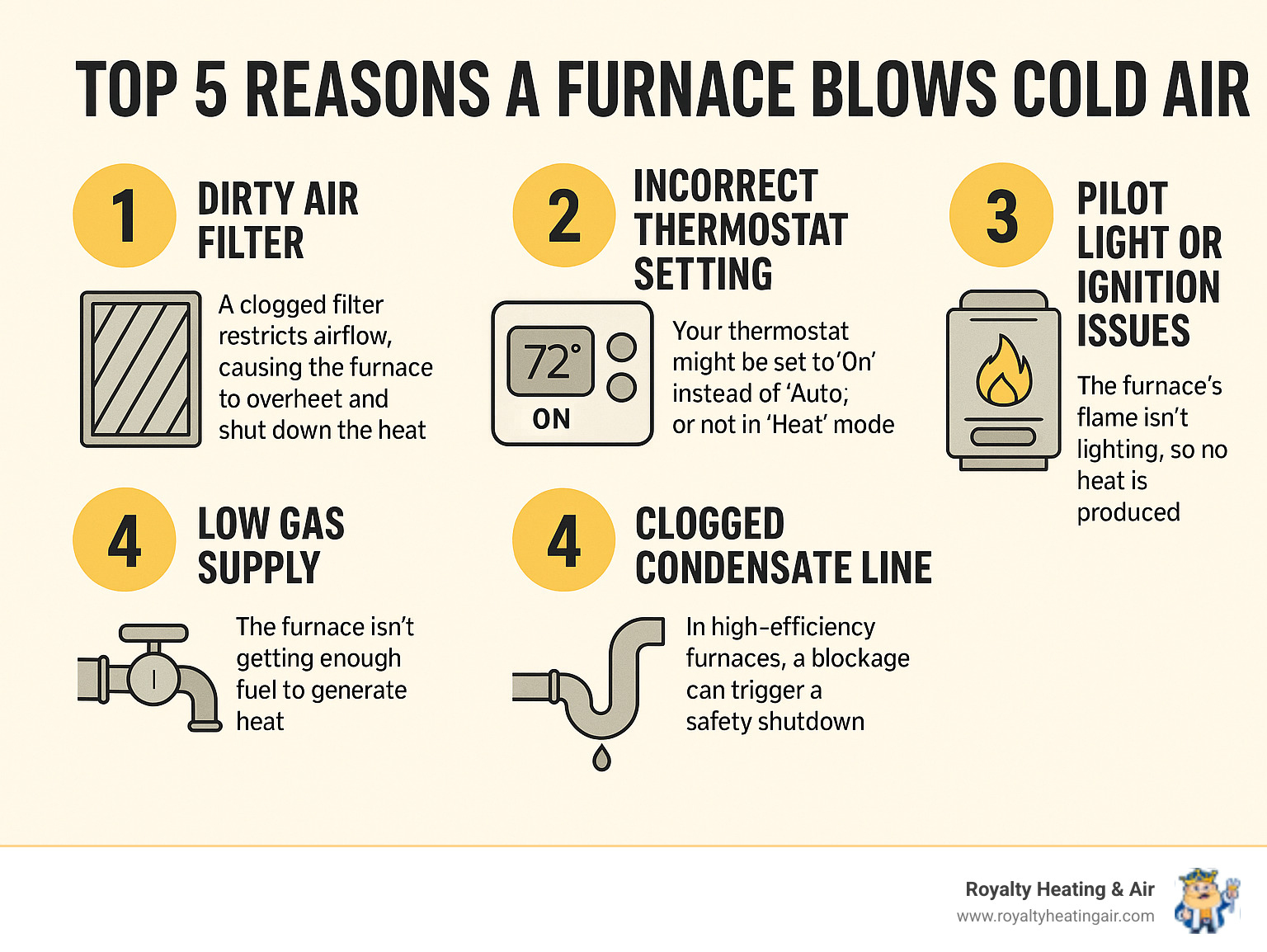
Before you panic and call in the cavalry (that's us!), there are a few simple troubleshooting steps you can take. Sometimes, the fix for a furnace blowing cold air is surprisingly easy. Think of these as your furnace's equivalent of "Have you tried turning it off and on again?"
This might sound like a no-brainer, but it's a common culprit! We've all been there: adjusting the thermostat in a hurry and accidentally hitting the wrong button.
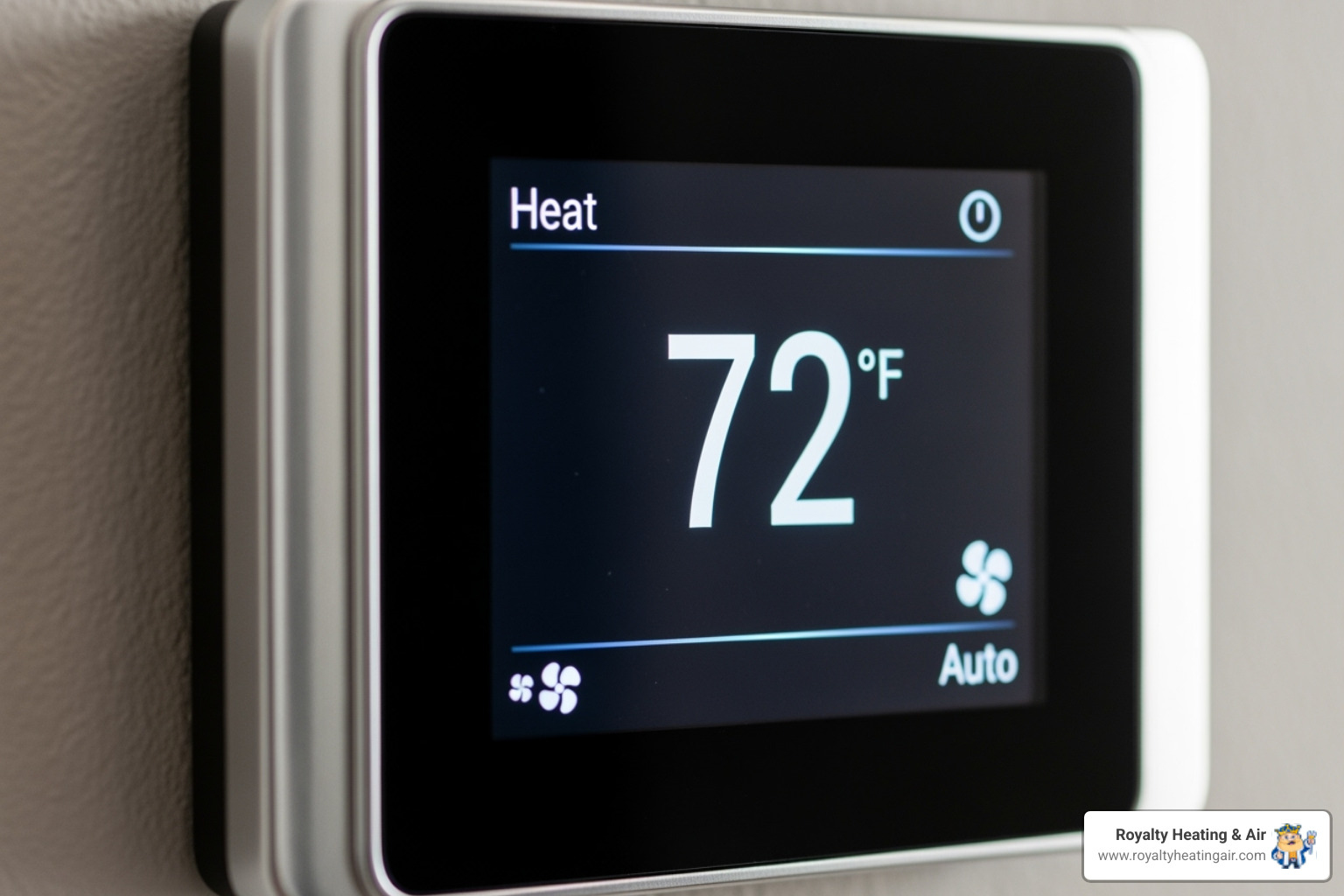
First, ensure your thermostat is set to 'Heat' mode. If it's still on 'Cool' from the summer, or even just 'Off', your furnace won't know it's supposed to be warming things up. Also, check that the temperature setting is higher than the current room temperature. If your home is 68°F and your thermostat is set to 65°F, it won't kick on for heat.
Next, take a look at your fan setting. Many thermostats have an 'On' and an 'Auto' setting for the fan.
Finally, don't forget the batteries! If your thermostat runs on batteries, low or dead batteries can cause it to malfunction and not signal the furnace correctly. If you have a smart thermostat, double-check its schedule to ensure it's not programmed to lower temperatures during the times you expect warmth.
This is one of the most common reasons we find a furnace blowing cold air, and it's something you can easily check yourself. Your air filter is like your furnace's lungs; it catches dust, dirt, and allergens, keeping the air in your home clean and protecting your furnace's internal components.
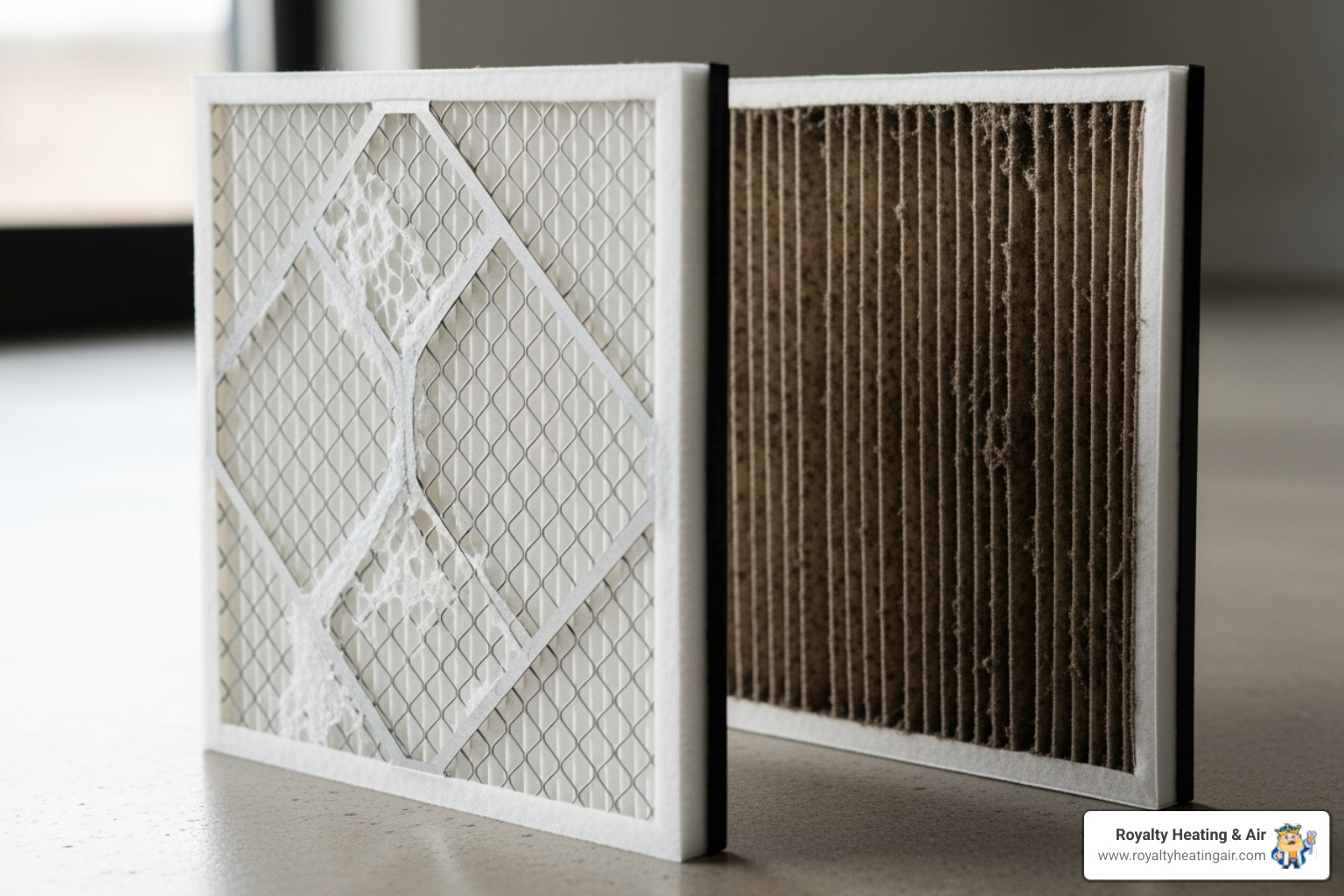
However, a dirty, clogged air filter can become a serious problem. It restricts the airflow into your furnace, forcing the system to work harder than it should. When airflow is severely restricted, your furnace can overheat. To prevent damage (and potential fire hazards!), furnaces have a built-in safety device called a limit switch. This switch will shut off the burners if the furnace gets too hot, but the fan often continues to run to cool the unit down. The result? Your furnace blowing cold air, even though it's trying its best to save itself!
We recommend checking your furnace filter monthly and replacing it at least every three months, though timing may vary based on filter size, household pets, and allergies. Replacing a dirty filter is a quick fix that can restore proper airflow and often resolve the cold air issue. Just make sure to turn off your furnace before you inspect or change the filter!
Sometimes, the problem isn't with the furnace itself, but with how the air is moving (or not moving!) through your home.
Take a stroll around your house and check all your air vents. Ensure that both your return air vents (where air is pulled into the system) and your supply vents (where heated air comes out) are open and unobstructed. Furniture, curtains, or even playful pets can accidentally block a vent, preventing proper airflow. If a return vent is blocked, the furnace won't get enough air to heat and distribute efficiently, leading to weak airflow or cold air.
Also, it's worth checking your electrical panel. Your furnace runs on electricity, and like any other appliance, its circuit breaker can trip, cutting off power. A tripped breaker will prevent your furnace from operating at all, including producing heat. Locate your furnace's breaker and if it's in the 'Off' or middle position, simply flip it firmly to 'On'. If it trips again immediately, there's an underlying electrical issue that needs professional attention. Some furnaces also have a reset switch, often near the blower motor, which you can try pressing after ensuring power is off for a few minutes.
If those simple checks didn't quite do the trick, don't worry! It just means we need to dig a little deeper. The issues below are some of the most common reasons your furnace blowing cold air might be leaving you in the chill. These often require a bit more detective work or, sometimes, the helping hand of a professional.
The heart of your furnace's heating process lies in its ability to ignite fuel. Without a working ignition system, your furnace can't produce that cozy warmth you're craving.
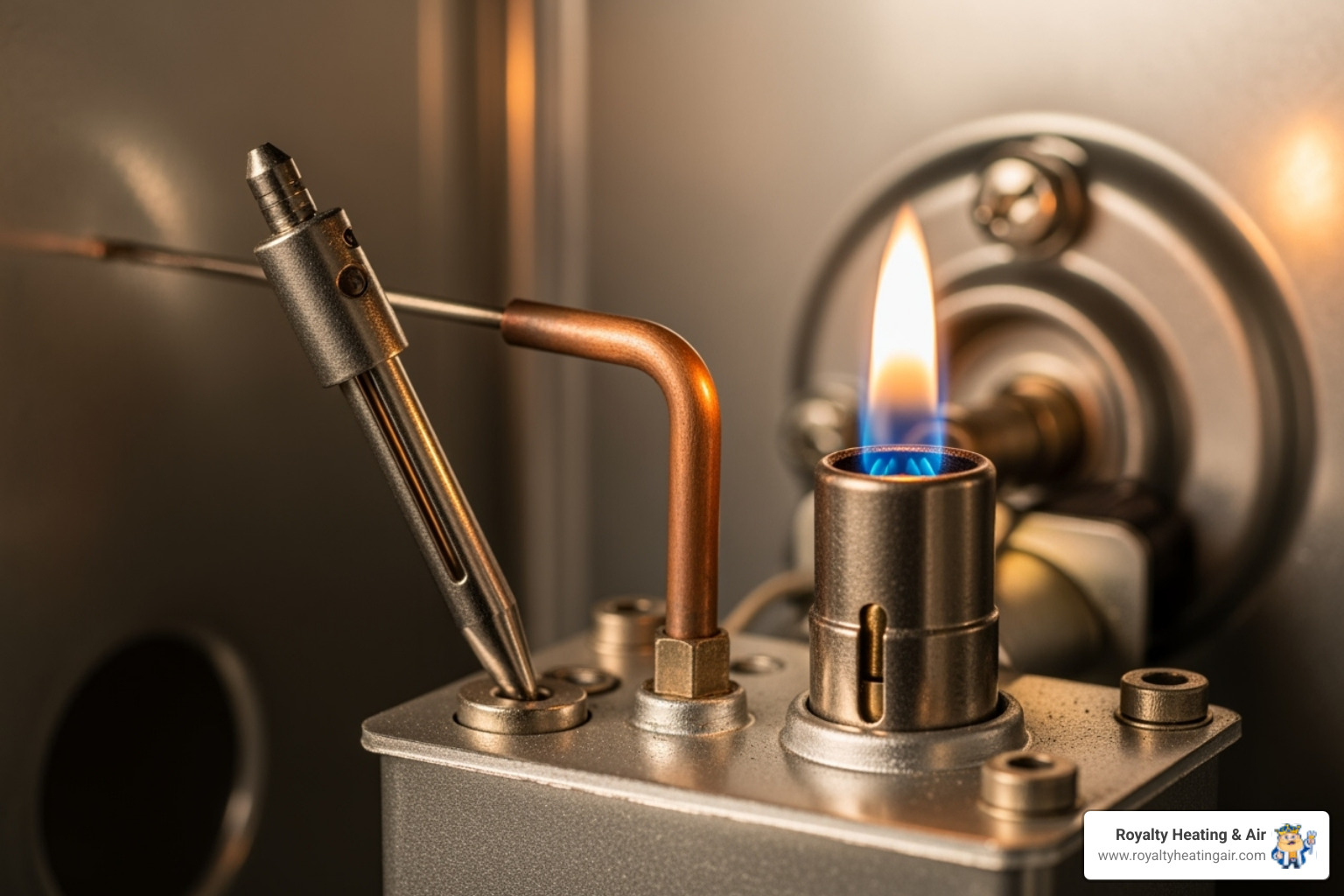
For Older Furnaces (with Pilot Lights): Many older gas furnaces rely on a small, continuous flame called a pilot light. This little flame is always on, ready to ignite the main burner when your thermostat calls for heat. If you find your pilot light is out, your furnace simply won't heat. Pilot lights can go out for a few reasons, like a sudden draft, dirt buildup, or a problem with a safety sensor called a thermocouple. If you're comfortable and don't smell gas, you can often relight it by following the instructions usually printed right on your furnace's access panel. However, if you smell gas, or if the pilot light goes out again soon after relighting, turn off your gas supply to the furnace immediately and call in an expert. A flickering or yellowish pilot flame can also signal a problem, so keep an eye out for that too.
For Modern Furnaces (with Electronic Ignition/Flame Sensors): Most furnaces made after 2010 don't have a standing pilot light. Instead, they use a clever electronic ignition system that sparks the gas only when heat is needed. A frequent troublemaker here is a dirty flame sensor. This sensor's job is to confirm that a flame is present after ignition. If it's covered in grime or soot, it can't "see" the flame. As a safety measure, the furnace will then shut off the gas supply, leaving you with a furnace blowing cold air. Sometimes, cleaning a flame sensor can be a DIY task with some fine-grit sandpaper, but if you're not sure, it's always safest to let a professional handle it.
It's pretty simple: no fuel means no heat! If your gas furnace isn't getting enough gas, it will definitely result in your furnace blowing cold air. Furnaces are designed with safety in mind, so they'll shut down completely if they detect a lack of sufficient fuel.
Start by checking the gas valve right near your furnace. It should be open, meaning the handle is parallel with the gas pipe. If it's perpendicular, it's closed! For homes with propane, ensure your tank isn't empty.
If these quick checks don't solve it, the issue might be deeper, like a problem with the gas line itself, or even a wider problem with your home's gas service. You can quickly check if other gas appliances in your home, like your stove or water heater, are working. If they're also not getting gas, contact your gas utility company right away. If it's just your furnace, it could be a faulty gas valve on the furnace itself or a blockage in its specific supply line. Any issues involving gas supply are serious and should always be handled by a qualified HVAC technician. It's truly not a DIY job due to the safety risks involved.
If you have a high-efficiency gas furnace, there's a little secret it keeps: it creates water as it heats your home! This water, called condensate, needs to drain away through a special line.
Over time, however, this condensate line can get blocked by algae, sludge, or other gunk. When that happens, the water backs up inside your furnace. Most high-efficiency furnaces have a clever safety switch (often a float switch) that detects this water buildup. When it's triggered, it wisely shuts down the furnace's burners to prevent water damage, leaving you with nothing but a furnace blowing cold air. You might be able to clear a small blockage yourself. Look for the drain line and see if you can find any visible clogs. Sometimes, a gentle brush or a water and vinegar solution can help. But if you're unsure, or if the problem keeps coming back, it's definitely best to call in a pro. Regular annual maintenance is a great way to prevent these clogs from ever happening!
Think of your home's ductwork as its very own circulatory system. It's designed to deliver all that lovely warm air from your furnace right to every corner of your house. But if your ducts are leaky or damaged, that precious heat can simply escape before it ever reaches you.
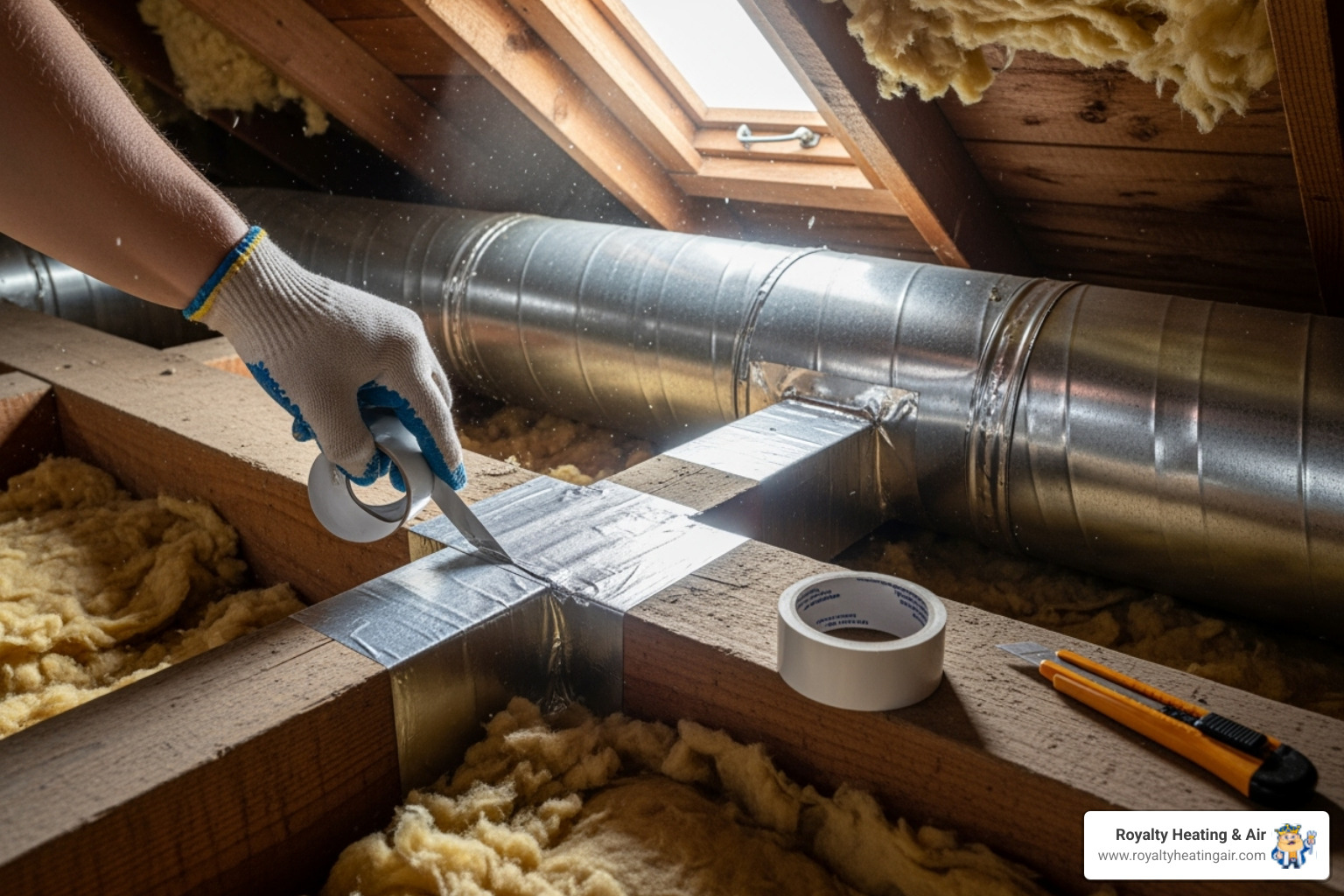
It's actually quite common! In a typical house, about 20% to 30% of the heated air can be lost through leaks, holes, or poorly connected ducts. This means your furnace could be working perfectly, generating all the heat it should, but you're still feeling cold because that warm air is escaping into unconditioned spaces like your attic, crawl space, or even inside your walls. On top of that, cold air from these unconditioned areas can get sucked into the ductwork and mix with your heated air, making the air coming out of your vents feel cool.
How do you know if you have leaky ducts? Watch out for these signs: you might notice higher energy bills without feeling any warmer, or uneven heating where some rooms are much colder than others. You might also spot increased dust in your home, or even visible gaps, tears, or disconnections in your ductwork, especially in unfinished areas like your attic or basement. While you can seal minor leaks with special mastic sealant or foil-backed tape (and please, don't use regular duct tape for this!), extensive damage to your ductwork really calls for professional attention. For more detailed information on sealing your ducts and why it's so important, you can check out the Energy Star guide: Duct sealing information from Energy Star.
We know it's tempting to fix everything yourself. And for some furnace problems, you absolutely can! But sometimes, your furnace blowing cold air points to something more serious or complex. These issues aren't just frustrating; they can be downright dangerous. If you've tried all our simple troubleshooting tips and your home is still chilly, or if you spot any of the following warning signs, it's definitely time to bring in a professional HVAC technician. For homeowners in Roseville, your safety and comfort are always our top priority.
This is arguably the most critical problem that can cause a furnace blowing cold air, and it's a major safety concern. Think of your heat exchanger as the "lung" of your furnace. It keeps the dangerous gases created during combustion (like carbon monoxide) separate from the warm, clean air that gets circulated into your home. If this part cracks, those harmful gases can mix with the air you breathe. That's a big no-no!
So, how can you tell if this serious issue might be happening? Keep an eye out for these signs:
Carbon monoxide (CO) is truly a silent killer. If your carbon monoxide detector goes off, or you have any reason to suspect a cracked heat exchanger, don't wait. Get everyone out of the house immediately and call 911 and your HVAC provider. For more crucial information on the dangers of carbon monoxide, please review the Dangers of carbon monoxide poisoning. It's incredibly important that every home has working carbon monoxide detectors, especially if you have any fuel-burning appliances.
Sometimes, the internal workings of your furnace need a professional touch. The control board is essentially the "brain" of your furnace. It tells all the different parts what to do and when to do it. If this circuit board starts to act up, it can send the wrong messages. For example, it might tell the blower fan to run constantly, but without telling the burner to ignite. The result? Your furnace blowing cold air for what seems like forever. You might even hear frustrating clicking sounds as it tries (and fails) to ignite.
Then there's the blower motor. Its main job is to push that warm air out into your home. But if the motor itself is dirty, failing, or having electrical issues, it might not move enough air, or it could run very inefficiently. This means even if the furnace is producing some heat, not enough of it gets to your vents, leaving you feeling chilly. Trying to figure out what's wrong with a complex component like a control board or a blower motor, and then fixing it correctly, needs specialized knowledge and tools. That's why it's a job for the pros.
Just like cars, appliances have a lifespan. Most furnaces are designed to last around 15 years, though some well-maintained units can go a bit longer. While regular tune-ups can certainly help your furnace live a long, happy life, an older unit is simply more likely to start having issues. You might find it's blowing cold air more often, breaking down more frequently, or just not heating your home as efficiently as it used to.
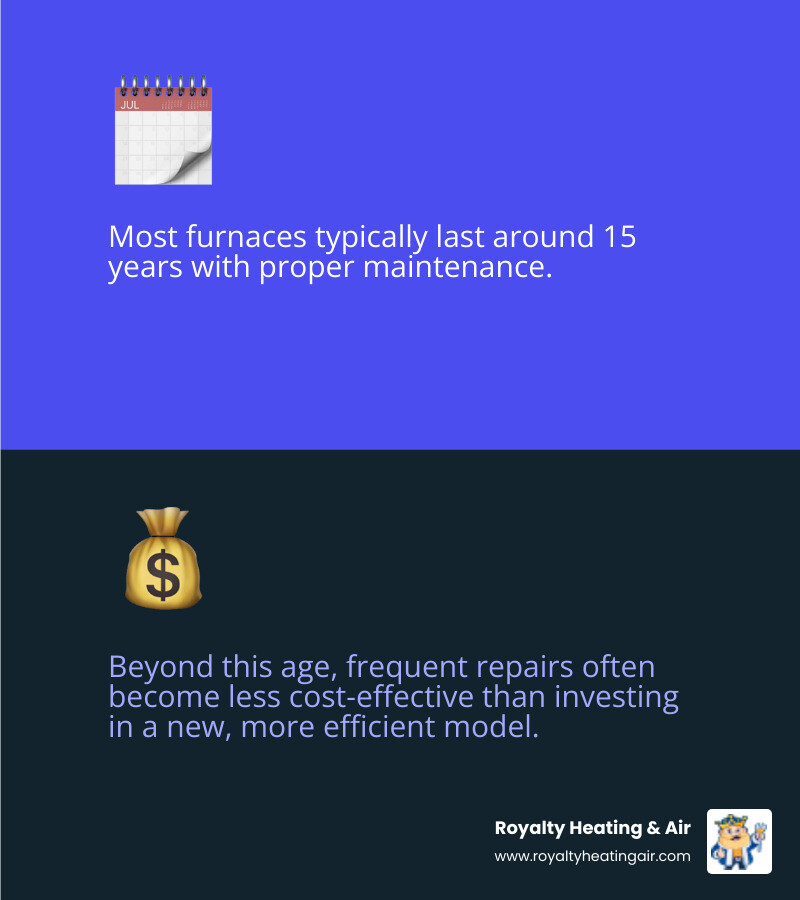
If your furnace is getting up there in age and you're constantly calling for repairs (especially if it's struggling to produce heat), it might be more economical in the long run to consider replacing it. A brand new, energy-efficient model can save you money on utility bills and provide much more reliable warmth. A trusted HVAC technician can come out, assess the overall health of your aging furnace, and help you compare the cost of ongoing repairs versus the benefits of investing in a new system. They'll help you make the best decision for your home and your wallet.
It's completely normal to have questions when your home comfort isn't quite right! We hear a lot of common concerns about furnaces that are blowing cold air, and we're happy to clear things up. Here are some of the questions we get most often from folks in the Roseville community:
This is actually a very common observation, and it's usually nothing to worry about! Think of it like this: when your furnace first gets the signal to start heating, the blower fan kicks on right away to get air moving through your ducts. But it takes a moment – a minute or two – for the actual heating process to begin. That's when the burners ignite and the heat exchanger starts warming up.
So, for that first minute, the fan is simply pushing out any cool air that was already sitting in your ductwork. Once the heat exchanger is ready, that beautiful, warm air starts flowing. If the air turns warm shortly after that initial cool burst, your furnace is likely working just as it should, warming your home efficiently.
Oh, absolutely! It might seem like a small thing, but a dirty air filter is one of the biggest culprits when it comes to a furnace blowing cold air. Imagine trying to breathe through a very thick blanket – it's tough! That's what your furnace is dealing with when its filter is clogged.
When the filter is packed with dust and debris, it severely restricts the airflow into your furnace. This makes the furnace work much harder than it should, and it can cause the heat exchanger (the part that gets super hot) to overheat. To protect itself from damage, your furnace has a built-in safety device called a limit switch. This smart little switch senses the overheating and will temporarily shut off the burners. However, the fan often keeps running to help cool the furnace down. The result? You're left with unheated, cold air blowing through your vents, even though your furnace wants to be making heat!
For older furnaces that still rely on a standing pilot light, relighting it yourself can often be safe, if you follow the proper steps. Most furnaces have clear, step-by-step instructions printed right on a label inside the furnace panel. It usually involves turning off the gas, waiting a few minutes for any lingering gas to clear out, and then carefully following the prompts to reignite the pilot flame.
However, your safety is always our number one concern. If you ever smell gas at any point, if you're unsure about any of the steps, or if the pilot light just won't stay lit after you relight it, do not proceed. Immediately turn off the gas supply to your furnace and give a professional HVAC technician a call. It's always better to be safe than sorry when dealing with gas appliances!
There's nothing quite like the unwelcome surprise of a furnace blowing cold air, especially when the chill really sets in here in Roseville, Loomis, Rocklin, Lincoln, or Granite Bay, CA. We know it's more than just a minor inconvenience; it can truly put a damper on your home's comfort. While we hope our simple troubleshooting tips have helped, some heating puzzles are just too complex for a DIY fix. That's when it's time to call in the pros!
Think of it this way: just like your car needs regular oil changes, your furnace benefits hugely from professional care. Annual tune-ups and preventative maintenance are your best friends when it comes to keeping your heating system happy and healthy. This helps your furnace run smoothly, saves you money on energy bills, and can even extend its lifespan. Plus, our skilled technicians can often spot small issues before they turn into big, chilly problems!
At Royalty Heating & Air, we're not just about fixing furnaces; we're about keeping our community warm in every sense of the word. We're proud to partner with the MackAttack Foundation, helping to support foster babies and sponsor family adoptions right here in our local area. When you choose us for your heating needs, you're not just getting top-notch service and lasting solutions; you're also helping us make a real difference in the lives of local families.
So, don't let a chilly furnace win the battle against your comfort. If you've tried our tips and your furnace is still blowing cold air, or if you suspect something more serious is going on, our friendly team of experts is ready to help.
Schedule your furnace repair in Roseville today, and let us bring that wonderful warmth back into your home!
